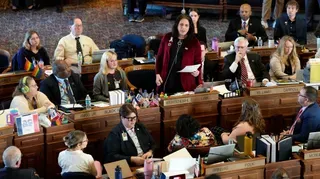December 10, 2012
HIV Rates Rise in Youth
Chris Sosa READ TIME: 6 MIN.
The number of new HIV infections in the United States remains relatively stable, standing at about 50,000 people annually.
But HIV, the virus that causes AIDS, is on the rise among younger Americans under the age of 25.
In fact, too many youth in the United States continue to become infected with HIV, federal officials said. And few are tested.
Those are two key take away points from a new report out by the Atlanta-based Centers for Disease Control and Prevention, which was released to coincide with World AIDS Day.
Specifically, young people between the ages of 13 and 24 in the U.S. account for more than a quarter of new HIV infections each year (26 percent) while 60 percent of these youth living with HIV are unaware they are infected, according to the CDC's Vital Signs report, released November 27.
The most-affected youth are gay and bisexual men and African Americans.
The analysis looked at the latest data on HIV infections, testing, and risk behaviors among young people.
The report offers insights into what kinds of behavior are driving the high rates of infection.
For example, young men who have sex with men - or MSM - were more likely to report having had sex with four or more partners or injecting illegal drugs.
In addition, among students who were currently sexually active, young MSM were also more likely to have used alcohol or drugs before their last sexual experience and were less likely to have used a condom.
And young MSM were also less likely to report having been taught about HIV or AIDS in school.
A silent epidemic
Medical professionals expressed concern over the report.
"The AIDS epidemic is silent," said Dr. Kenneth H. Mayer, medical research director of the Fenway Institute in Boston, in a phone interview. "It may have been horrible for older people, but youth don't know people who are very sick. They think of AIDS as a disease of old people, and it's a manageable disease. At least that is the youthful perspective."
Mayer is also the director of HIV prevention at Boston's Beth Israel Deaconess Hospital.
For African Americans, he said, discrimination, stigma, and homophobia are contributing factors to increased rates of HIV infection.
"These youth are very disenfranchised from society," Mayer explained. "If you are a young black man, you may have been ostracized by your family of birth, experienced racism - so there is a lot going on in your life."
Other independent factors, he said, that account for HIV infection among young black MSM are poverty, unemployment, being a bottom (receptive in anal intercourse), and having other sexually transmitted diseases.
"The economic factors that make more people susceptible to HIV speak to the fact that there is a whole set of structural issues that place young, urban, disenfranchised youth at risk for HIV," he said.
Indeed, the increased infection rates are worrisome for AIDS activists and service providers. Rebecca Haag, president and CEO of Boston-based AIDS Action Committee, offered an assessment concerning the report's findings.
"The CDC report is quite disturbing, but it doesn't really tell us anything that we did not already know. Young people, particularly young black and African American gay and bisexual men, are incredibly vulnerable to HIV infection and more than half of those who are infected with HIV are unaware of it. This is the perfect storm for spreading HIV," she said.
Haag was referring to the results of an earlier study, released this summer during the International AIDS Conference, which showed gay, bisexual, and black men between the ages of 18 to 30 are infected at a rate nearly three times more than whites.
The study enrolled more than 1,500 black, gay, and bisexual MSM, between 2009 and 2011, from six cities, including Atlanta, Boston, Los Angeles, New York, San Francisco, and Washington.
Mayer was a leader of the study.
Haag continued, "The CDC report calls for more community- and school-based interventions to help stop the spread of HIV among young people. We already know that this is what needs to happen. We've been doing this work for years and we continue to do it. But it is unconscionable that we do not have comprehensive sexuality education in every school.
"Our young people should know everything they need to know about how they can keep themselves safer from HIV infection. In order to end the AIDS epidemic, we need to employ every public health tool available to us to reduce new infections, and that includes educating those vulnerable to infection on ways to keep themselves safer," Haag added.
Overall, an estimated 12,200 new HIV infections in the U.S. occurred in 2010 among young people aged 13-24, with young gay and bisexual men and African-Americans hit harder by HIV than their peers. In 2010, for example, 72 percent of estimated new HIV infections in young people occurred in young men who have sex with men.
By race and ethnicity, 57 percent of estimated new infections in this age group were in African Americans.
Two data sources were used for HIV testing and risk behavior analysis, including surveys from public school students in grades 9-12 in 11 states (Connecticut, Delaware, Florida, Hawaii, Illinois, Massachusetts, Michigan, New Hampshire, Rhode Island, Vermont, and Washington) and nine large urban school districts (Boston, Chicago, Detroit, District of Columbia, Los Angeles, Milwaukee, New York City, San Diego, and Seattle).
"That so many young people become infected with HIV each year is a preventable tragedy," CDC Director Dr. Thomas R. Frieden told reporters during a conference call last week to discuss the findings.
"All young people can protect their health, avoid contracting and transmitting the virus, and learn their HIV status," he said. "This is our future generation and the bottom line is that every month 1,000 youth are becoming infected with HIV."
He added, "HIV, despite the great treatments that we have, remains an incurable infection. And the cost of care of a single patient is approximately $400,000 over their lifetime. That means we are incurring about $400 million in health care costs, and every year $5 billion from preventable infections in youth."
Despite recommendations from CDC and the American Academy of Pediatrics that call for routine HIV testing of youth in medical settings, the Vital Signs analysis showed that 35 percent of 18-24 year olds have been tested for HIV, while only 13 percent of high school students - and 22 percent of sexually experienced students - have ever been tested.
"The key here for clinicians is to make it routine," said Frieden. "It is routine screening just as we screen adults for high cholesterol, we screen people for HIV infection."
Test then treat
Of course, testing is only the first step to treatment, which can lead to improved patients' health if they are found to be HIV-positive, as well as prevent them from spreading infection.
The phenomenon is known as "treatment cascade," which Frieden addressed during the conference call. By "improving what we call the treatment cascade, increasing the number and proportion of people whose infection is controlled whose viral load is suppressed, we will reduce the risk for everyone in society," he said. "That's a critical goal for us to work with communities, health care providers, and most importantly with people infected with HIV so they can get the care and services they need to live long and productive lives, be healthy, stay out of the hospital, and not to infect other people."
Furthermore, studies have shown that people who know they are HIV-positive are less likely to engage in risky behaviors, such as unprotected sex and sharing needles.
"We can and must achieve a generation that is free from HIV and AIDS," said Dr. Kevin Fenton, director of the National Center for HIV/AIDS, Viral Hepatitis, STD, and TB Prevention at the CDC.
"It will take a concerted effort at all levels across our nation to empower all young people, especially young gay and bisexual youth, with the tools and resources they need to protect themselves from HIV infection," he said.
An openly gay man, Fenton, who participated in the conference call, is stepping down from his position at the end of the year to return to his native England. He has served as head of the CDC's HIV/AIDS division for seven years.
Currently, an estimated 1.2 million people in the U.S. are living with HIV.







